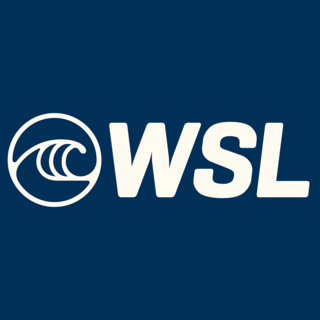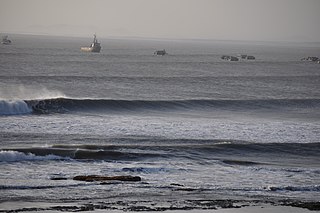Related Research Articles

Surfing is a surface water sport in which an individual, a surfer, uses a board to ride on the forward section, or face, of a moving wave of water, which usually carries the surfer towards the shore. Waves suitable for surfing are primarily found on ocean shores, but can also be found in standing waves in the open ocean, in lakes, in rivers in the form of a tidal bore, or in wave pools.

Nazaré is a Portuguese town and municipality located in the Oeste region, in the historical province of Estremadura, and in the Leiria District. The municipality has a population of 14,889 in an area of 82.43 km2, while the town itself has around 10,000 inhabitants.

The Banzai Pipeline, or simply Pipeline or Pipe, is a surf reef break located in Hawaii, off Ehukai Beach Park in Pupukea on O'ahu's North Shore. A reef break is an area in the ocean where waves start to break once they reach the shallows of a reef. Pipeline is known for huge waves that break in shallow water just above a sharp and cavernous reef, forming large, hollow, thick curls of water that surfers can tube ride. There are three reefs at Pipeline in progressively deeper water farther out to sea that activate according to the increasing size of approaching ocean swells.

The World Surf League (WSL) is the governing body for professional surfers and is dedicated to showcasing the world's best talent in a variety of progressive formats. The World Surf League was originally known as the International Professional Surfing founded by Fred Hemmings and Randy Rarick in 1976. IPS created the first world circuit of pro surfing events. In 1983 the Association of Surfing Pros took over management of the world circuit. In 2013, the ASP was acquired by ZoSea, backed by Paul Speaker, Terry Hardy, and Dirk Ziff. At the start of the 2015 season, the ASP changed its name to the World Surf League. Sophie Goldschmidt was appointed as WSL CEO on 19 July 2017. Paul Speaker had stepped down as CEO on 11 January 2017, and Dirk Ziff acted as the interim WSL CEO until Goldschmidt's appointment.

Cortes Bank is a shallow seamount in the North Pacific Ocean off California. It is 96 miles southwest of San Pedro in Los Angeles, 111 miles west of Point Loma in San Diego, and 47 miles southwest of San Clemente Island in Los Angeles County. It is considered the outermost feature in California's Channel Islands chain. At various times during geologic history, the bank has been an island, depending on sea level rise and fall. The last time it was a substantial island was around 10,000 years ago during the last ice age. It is possible that this island was visited by the first human inhabitants of the Channel Islands, most notably San Clemente Island, whose seafaring residents would have been able to see the island from high elevations on clear days.
G-Land, also known as Plengkung Beach, is an internationally renowned surf break on Grajagan Bay, Banyuwangi, Alas Purwo National Park, East Java, Indonesia, about half a day by road from the popular tourist destinations of Bali. It is most commonly reached via boat charter from Bali.

Malabrigo also called unofficially Puerto Chicama, is a port and small coastal city in northwestern Peru, located in La Libertad Region, some 70 km north of Trujillo city. The town is home to the Chicama wave, the first legally protected wave in the world, as well as the world's longest left-breaking wave—see External Links.
Surf forecasting is the process of using offshore swell data to predict onshore wave conditions. It is used by millions of people across the world, including professionals who put their forecasts online, meteorologists who work for news crews, and surfers all over the world. It is impossible to make an exact prediction of the surf, but by knowing a few factors a good prediction can be made. One needs to have an understanding of how waves are formed, a basic knowledge of bathymetry, and information about the surf spot being forecasted to accurately forecast the surf.

Hawaiian scale is an expression of the height of a wind wave affecting water. It is the expression conventionally used by surfers in Hawaii and is also used in Australia and parts of South Africa.

Lake surfing is surfing on any lake with sufficient surface area for wind to produce waves. As with ocean surfing, ideal wave conditions are when the wind switches offshore. However, when this occurs over a lake the waves generated by previous onshore wind subside relatively quickly. This means lake surfers have a shorter window of opportunity to surf ideal waves. Lake surfers are often out during and experiencing the same storm that creates the waves whereas ocean surfers are more often surfing on swell produced by storms hundreds of miles away and that may have taken days to reach shore. In addition to making it more difficult to manage surfboards, high winds can make the face of a wave and water surface rough. Increased wave frequency due to shorter fetch results in less rest between waves and sets of waves. This can make it necessary to paddle out through waves because there may not be a long enough pause between sets to paddle out between them.

Troncones is a relatively undeveloped, uncrowded beach village located about 20 miles (32 km) north west of Zihuatanejo on the coast of the state of Guerrero. It is located in the municipality of La Unión de Isidoro Montes de Oca and has a population of about 593 people. Hammocks and palm trees are in most yards, chickens roam the streets and loud nightlife is limited to very few weekly events, making for quiet nights. Some local hotels and restaurants offer special events such as Movie Nights and Dance Parties, mostly during the Oct-May high season. On Sundays, El Burro Boracho has shows of Mexican folkdance.

Encuentro Beach is an isolated stretch of beach in the Puerto Plata province of the Dominican Republic. Located between the more heavily populated cities of Sosúa and Cabarete this popular surfing beach is accessible to the public via dirt roads.

A surf break is a permanent obstruction such as a coral reef, rock, shoal, or headland that causes a wave to break, forming a barreling wave or other wave that can be surfed, before it eventually collapses. The topography of the seabed determines the shape of the wave and type of break. Since shoals can change size and location, affecting the break, it takes commitment and skill to find good breaks. Some surf breaks are quite dangerous, since the surfer can collide with a reef or rocks below the water.

Teahupoʻo is a village on the southwestern coast of the island of Tahiti, French Polynesia, in the southern Pacific Ocean.

The North Shore, in the context of geography of the Island of Oʻahu, refers to the north-facing coastal area of Oʻahu between Kaʻena Point and Kahuku. The largest settlement is Haleʻiwa.

Ecuador has many beaches for surfing: the coast of Ecuador is 2,237 km long. Surfable waves are available in Ecuador year-round, and surfers enjoy the mild year-round weather, especially in the northern region where the weather conditions attract many surfers from all over the world. Within this part of South America, Ecuador's neighbors Chile and Peru also offer great surfing. Many surfers in Ecuador use a protective wetsuit. Surf tourism is very important to the local economy, and the beaches offer significant enjoyment because of top quality waves combined with affordable prices for lodging and food compared to other surf destinations. There's also a national marine reserve off the coast, which has a gigantic whale population.

Sidi Kaouki is a small town located 25 km south of Essaouira. It is a rural commune in Essaouira Province of the Marrakech-Tensift-Al Haouz region of Morocco. At the time of the 2004 census, the commune had a total population of 4335 people living in 902 households.

Uluwatu is a region on the south-western tip of the Bukit Peninsula of Bali, Indonesia. It is home to the Pura Luhur Uluwatu temple.

Surfing was first introduced to the United Kingdom in 1890 and has since become a popular pastime, particularly in Cornwall, North Devon, and South Wales. With approximately 500,000 people participating per year, it contributes over £1.8 billion to the UK economy annually. GB Surfing is the primary governing body for the sport of surfing in the United Kingdom.

New Zealand is a popular surfing destination, with a long history of the sport and a varied coastline with locations suitable for all types of surfing. The West coast is notably consistent, with big swells and high winds, whereas the east coast is dominated by cyclone season swells; the North island is notably warmer than the South, but less consistent; mean temperatures range from 7 °C to 20 °C, depending on location and time of year. Winter is more consistent than Summer, with a southeasterly swell. The climate of New Zealand is varied, so different surf conditions are encountered across the islands.